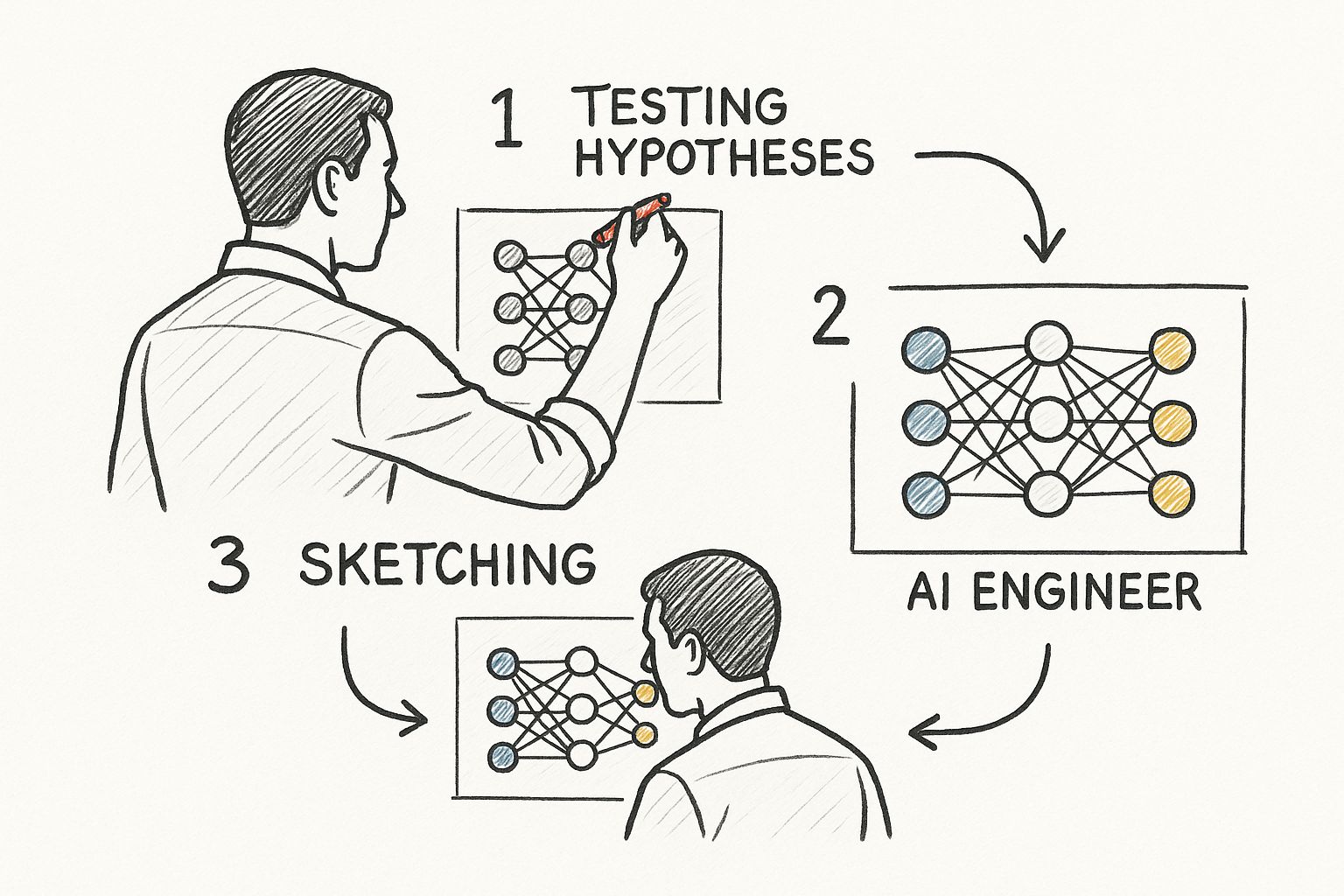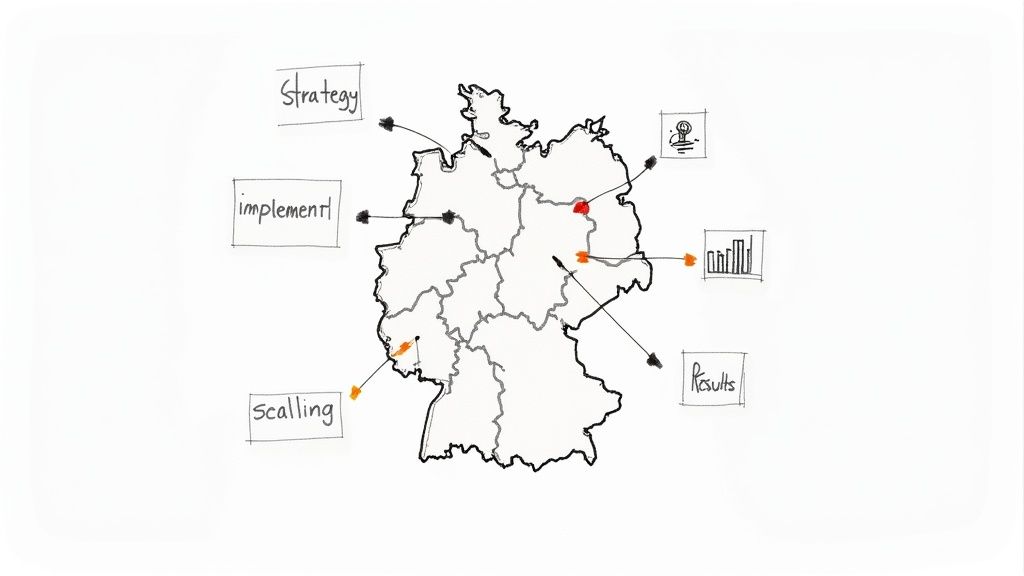A Practical Guide to Hands-On AI Consulting
Unlock business value with hands-on AI consulting. Our guide covers strategy, implementation, and measurement for real-world results. Start your transformation.

Too many businesses get bogged down in the AI planning stage, caught in a cycle of endless meetings about potential but never seeing any real results. The hard truth is that a purely theoretical approach rarely delivers. This is where hands-on AI consulting comes in, bridging that crucial gap between a strategy on paper and concrete execution that drives measurable business value.
Moving Beyond Theory: The Real Value of Hands-On AI Consulting
There’s a world of difference between being handed a static AI roadmap and actually building solutions alongside experts. It's the classic distinction between theory and application. While high-level AI strategy consulting offers a vital starting point, real momentum builds when you shift from abstract plans to practical, collaborative work.
This is the heart of a hands-on engagement. Instead of just delivering a document and walking away, consultants roll up their sleeves and become an extension of your team. This process of AI co creation completely changes the project's dynamic—and its chances of success.
The contrast between these two styles of consulting is stark. One delivers ideas, while the other delivers working solutions.
Theoretical vs Hands-On AI Consulting Approaches
Aspect
Theoretical AI Consulting
Hands-On AI Consulting
Consultant's Role
Advisory; provides reports, roadmaps, and high-level recommendations.
Collaborative; works alongside the client's team to build and implement solutions.
Deliverables
Strategy documents, presentations, market analysis reports.
Working prototypes, deployed models, custom-built tools, and trained internal teams.
Client Involvement
Primarily passive; receives and reviews consultant outputs.
Highly active; participates in workshops, development sprints, and testing.
Risk
High risk of the strategy being impractical or misaligned with operational reality.
Lower risk due to iterative development, early feedback, and continuous validation.
Knowledge Transfer
Limited; knowledge stays with the consultant or within documents.
Intrinsic; the client team learns by doing and builds lasting internal capabilities.
Time to Value
Long; value is only realised if the client can successfully execute the plan independently.
Short; tangible results and business value are demonstrated quickly through pilots and MVPs.
Ultimately, a hands-on approach is designed to produce tangible outcomes, not just well-researched documents. It prioritises practical application and ensures the final solution is genuinely fit for purpose.
De-risking and Accelerating AI Projects
A hands-on methodology significantly de-risks AI initiatives. By building, testing, and iterating in short cycles, we can spot and resolve potential issues early on, heading off costly mistakes before they snowball. This collaborative model also massively accelerates your team’s learning curve, building internal skills that stick around long after our engagement ends.
The goal isn't just to deliver a solution. It's to make sure the final product is perfectly aligned with your unique operational realities. This practical involvement guarantees that the technology serves the business, not the other way around.
This practical approach is becoming more critical, especially in robust, growing markets. For instance, Germany's AI market revenue is projected to surge from around USD 309 million in 2025 to USD 1.36 billion by 2035. This growth is fuelled by a strong demand for services like hands-on AI consulting that support everything from initial strategy to final deployment. You can find more insights on this trend from Grand View Research.
From Strategy to Execution
The journey starts by turning a high-level plan into an actionable blueprint. This means moving beyond broad strokes to define specific, measurable goals that solve real business problems. A critical step here is a thorough AI requirements analysis, which clarifies the precise needs of the project before a single line of code is written.
Ultimately, hands-on AI consulting ensures your AI strategy framework isn’t just a theoretical document gathering dust, but a living guide for execution. This shift from passive advice to active participation is what allows businesses to achieve a genuine competitive advantage. You don’t just get a map; you get a seasoned guide to walk the path with you, making sure you reach your destination.
The Foundation: Designing Your AI Strategy Framework
A successful AI project never starts with writing code. It begins with a solid, well-thought-out plan. This is where hands-on AI consulting really shows its worth right from the start, taking you from fuzzy ideas to a clear, actionable blueprint for what comes next. The whole process kicks off with a deep, collaborative discovery phase.
This isn't your typical Q&A session. A good consultant gets in the trenches with your team—from the C-suite right down to the people on the front lines. The aim is to dig into the real business challenges and pinpoint those high-impact opportunities where AI can actually make a difference. We’re talking about translating a broad goal like "let's be more efficient" into something specific and measurable, like "let's automate 50% of our manual invoice processing within the next six months."
This diagram gives you a sense of how we funnel those abstract ideas through a structured process to land on a concrete, executable plan.

It really shows the journey from initial brainstorming and testing out ideas to having a refined schematic that connects every single step to a clear business outcome.
From Vague Goals to Concrete Objectives
One of the most crucial steps, and one that often gets glossed over, is the AI requirements analysis. This is a detailed process that makes sure every technical decision we make is directly solving a business problem. Instead of jumping straight to solutions, a hands-on approach always puts understanding the "why" before the "how."
Let's take a real-world example. A retail company might say they want to "personalise the customer experience." A proper analysis would break that down into specifics:
- Objective: Increase the repeat purchase rate by 15%.
- Requirement: We need to build a recommendation engine that suggests products based on what customers have bought before and how they browse the site.
- Data Needed: This will require customer transaction logs, website clickstream data, and current product inventory levels.
Getting to this level of detail is what separates a successful project from a failed one. It builds the solid foundation we need before any technical work can begin.
The most effective AI strategy isn't a document that’s handed to you. It’s a living blueprint that's co-created with you. It has to reflect your organisation’s unique context, day-to-day realities, and overall readiness if you want it to be both ambitious and achievable.
This focus on getting the initial framework right is something we're seeing across the entire market. The global AI consulting services market is expected to explode from USD 11.07 billion in 2025 to nearly USD 91 billion by 2035, and hands-on services are a massive part of that growth. It shows that more and more businesses realise they need guidance to navigate these complex integrations, from figuring out if they're even ready for AI to getting it deployed.
Ultimately, this kind of collaborative planning ensures the AI strategy framework is a shared vision, not just another document gathering dust. It sets a clear, agreed-upon path for the implementation that follows, getting everyone aligned and building momentum right from day one.
From Blueprint to Reality: The Implementation Phase

Once we've nailed down the strategy, it’s time to roll up our sleeves. This is where the real work begins, and it’s what sets hands-on AI consulting apart from traditional advisory services. We're moving from diagrams on a whiteboard to a real, working solution that your team can touch and feel. It’s a dynamic, collaborative phase focused on delivering tangible results, fast.
We build everything based on agile principles. Forget the old model where consultants disappear for six months and come back with a "big reveal." That just doesn't work for AI. Instead, we work in short, focused sprints. This lets us build a minimal version of the tool—a rapid prototype—to test our core ideas and get immediate feedback from your team.
This back-and-forth is crucial. The constant dialogue between our consultants and your internal experts keeps the project grounded and ensures it continues to solve the actual business problem. It’s a completely transparent process that takes the mystery out of AI development.
Agile Development and Rapid Prototyping
Adopting an agile approach is our secret to keeping projects on track. Instead of one huge, high-stakes delivery at the very end, we break the work into smaller, manageable chunks. This has some serious advantages:
- Early Validation: You get to see tangible progress almost immediately. This allows your team to confirm we’re building the right thing from day one.
- Flexibility: Business needs can change, and technical roadblocks pop up. This way, we can pivot quickly without throwing the whole project into chaos.
- Momentum: Nothing builds confidence like seeing progress. Hitting small, consistent milestones keeps everyone motivated and stakeholders happy.
Imagine a project to automate customer support. We wouldn't try to build a system that handles every possible query from the start. A much smarter approach is to begin with a prototype that only answers the top three most frequent questions. Once we’ve perfected that, we can expand its skills in the next sprint. We map out these initial sprints together in our AI discovery workshops.
Navigating Technical Complexities with an Expert Team
Let's be honest: implementing AI can get technically messy. You're dealing with complex data integrations, finicky model training, and tricky system deployments. This is exactly where having a seasoned partner pays off. Our team has been down this road many times before and knows how to spot and solve problems before they escalate.
A core part of our philosophy is that hands-on implementation shouldn't just be about delivering a product. It's about building your team's own capabilities. We work openly and collaboratively to make sure you not only get a solution but also understand how it ticks and how to keep it running.
This focus on knowledge transfer is non-negotiable for us. We work side-by-side with your developers, data scientists, and IT teams. While we manage the project, we’re also explaining the "why" behind our decisions—from choosing the right algorithm to architecting a data pipeline that can scale.
By the time we're done, you don't just have a shiny new tool. You have a more skilled and confident team, ready to tackle the next AI initiative. It’s this partnership model that truly turns an AI blueprint into a business reality.
Alright, let's move beyond the hype. The real trick to successful AI isn't just about adopting new technology; it’s about being incredibly selective. Anyone can list a dozen things AI could do, but the real expertise lies in finding the one or two opportunities that will genuinely move the needle for your business.
This is where the hard work of opportunity analysis comes in. We’re not just looking for technically flashy projects. Instead, we weigh the potential return against what’s actually feasible with your current setup and—most importantly—how it fits into your bigger picture. The best AI projects always live at that sweet spot where ambition, reality, and business strategy meet.
Turning a Wish List into a Real-World Plan
You probably have a long list of "what-ifs." The goal is to transform that into a practical, prioritised portfolio of AI projects. This means mapping every single idea against your core business objectives and, just as crucially, your resource constraints. It’s a hands-on, collaborative process that ensures every project we green-light has a rock-solid business case behind it.
Think about a logistics company, for example. They could be looking at:
- Predictive Maintenance: Using sensor data to fix equipment before it breaks down.
- Route Optimisation: Dynamically creating smarter delivery routes to cut fuel costs and save time.
- Automated Warehousing: Bringing in robots to handle inventory and get orders out the door faster.
Each one is a solid idea. But which one do you tackle first? That's a strategic decision, and it’s precisely where a tool like an AI Strategy consulting tool can bring much-needed clarity.
The Art of Balancing Quick Wins and Big Bets
A truly effective AI roadmap is never just about one type of project. You need a healthy mix. I always recommend clients start by identifying a few "quick wins"—smaller projects that deliver a clear, high impact fast. Getting these early victories on the board is absolutely vital. It builds momentum, quiets the sceptics, and gets stakeholders excited for the bigger, more complex initiatives down the road.
Honestly, a well-chosen first project does more than just solve a problem. It proves the value of AI to the entire organisation, turning doubt into genuine enthusiasm. It’s about showing, not just telling.
By digging into a wide range of real-world use cases, you start to get a feel for what's actually possible for you, right now. This is how you build a roadmap that makes sense, starting with foundational projects and then building up to more sophisticated deployments over time, as we explored in our AI adoption guide.
This disciplined approach to choosing projects is central to our AI co creation philosophy. When you work alongside our expert team, you're not just getting a plan. You're learning how to see opportunities through a strategic lens, making sure your AI journey starts strong and delivers results from the very beginning.
Making Sure the Juice Was Worth the Squeeze: Measuring Real-World AI Impact
So, you’ve launched your new AI system. How do you actually know if it's working? A proper hands-on AI engagement doesn't just stop once the technical work is done. The real test comes next: measuring the business impact and making sure the value you've created is built to last.
This goes way beyond checking technical stats like model accuracy. Frankly, those numbers don't mean much on their own. We need to connect the AI's performance directly to your company's bottom line. That means focusing on key performance indicators (KPIs) that leadership understands—things like tangible cost savings, new revenue, or measurable boosts in how efficiently your teams operate.
To do this right, we have to establish a clear baseline before a single line of code is written. It’s simple, really: you can't know how far you've come if you don't know where you started.
From Technical Metrics to Business Wins
Tracking progress isn't a one-and-done deal; it's an ongoing process. We sit down with you to define the KPIs that genuinely matter to your specific business goals, not just the ones that sound impressive in a data science lab.
Here are a few real-world examples of what that looks like:
- Less time on manual tasks: An automation project we delivered resulted in a 40% drop in the hours a client's team spent on tedious data entry.
- Higher customer conversions: A new recommendation engine for an e-commerce site led to a 15% uplift in customers adding items to their cart.
- Lower operational costs: By optimising a client's logistics, their new AI model cut fuel expenses by 10%.
These are the kinds of results that truly validate the investment and make it much easier to get buy-in for future AI work. Without this sharp focus on business outcomes, even the most brilliant AI is little more than an expensive experiment.
The ultimate goal of a hands-on engagement is to empower your organisation. We aim to help you own, manage, and scale your AI capabilities independently, turning a one-time project into a continuous source of competitive advantage.
Creating a Cycle of Constant Improvement
An AI solution isn't something you launch and forget. Think of it as the starting line for a new, smarter way of operating. This is where solid governance becomes essential. We'll help you set up a continuous improvement cycle, allowing you to refine your AI models as new data flows in and your business priorities shift. This is a foundational principle for any lasting AI success, a topic we dive into in our AI adoption guide.
This final phase is all about embedding a culture of data-driven thinking across your entire organisation. By the time we're done, the goal is for our expert team to have passed on the knowledge and skills your people need to take full ownership. This approach ensures the value we build together doesn't just stick around—it grows, strengthening your ability to innovate for years to come.
Answering Your Questions About Hands-On AI Consulting
It’s completely normal to have questions when you’re thinking about shifting from talking about AI to actually doing it. Moving towards a practical, implementation-first approach is a big step, so let's clear up some of the common queries we hear. We want you to feel confident about what this kind of partnership really looks like.
For an even deeper dive, feel free to check out our complete FAQ page.
How Is This Different From My Usual AI Advisory?
The biggest difference is in the outcome: we deliver working solutions, not just slide decks.
Traditional AI strategy consulting often ends with a strategic document—a roadmap outlining the what and the why. The problem is, the how is left entirely on your team's shoulders. We’ve all seen well-meaning, expensive plans gather dust because the team lacked the time or specific skills to execute them.
Hands-on consulting flips that script. We’re not just advisors; we become an extension of your team. Our experts roll up their sleeves to write code, set up systems, and work side-by-side with your people. It's about collaboration and AI co creation, turning strategy into something real and measurable.
What's a Realistic Timeline for a Hands-On AI Project?
While every project has its own unique complexities, the goal here is always to get you value, fast. You shouldn’t have to wait years to see a return. A typical engagement with us is structured to deliver results quickly.
- Discovery & Strategy (2–4 weeks): We kick things off with intensive workshops. This isn't about endless meetings; it's about focused work to nail down the strategy and map out the technical requirements.
- Implementation Sprints (8–12 weeks): With a clear plan, we jump straight into building. We work in agile sprints to develop and deploy an initial Minimum Viable Product (MVP).
This approach means you'll have a tangible, working product in your hands within a few months, not a few years. It’s all about rapid prototyping and delivering real business impact from the get-go.
How Do You Make Sure My Team Can Take Over Afterwards?
This is a huge part of our philosophy. Our job isn't done until your team is fully equipped to run, maintain, and build upon the solution we’ve created together. We don't want you to be dependent on us forever.
Knowledge transfer is woven into the entire process, not just handed over at the end. Here’s how we do it:
- Paired Programming: Our engineers sit (virtually or physically) with your developers, sharing screens and solving problems together.
- Regular Workshops: We host practical, interactive sessions to break down complex concepts and review the work being done.
- Clear Documentation: We document everything meticulously, from the architecture down to the code comments, so there are no black boxes.
Our expert team is committed to upskilling your people. You get a powerful AI solution and the internal expertise to keep the momentum going long after our engagement ends.
Ready to move from AI theory to tangible business impact? With Ekipa AI, you can discover and execute AI transformation opportunities faster than ever. We turn your ideas into scalable, real-world solutions. Get your tailored AI strategy today.



